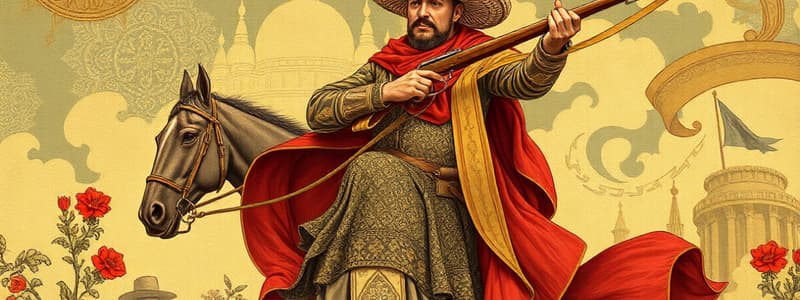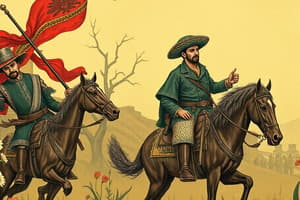Podcast
Questions and Answers
Which action directly triggered Francisco Villa's adoption of the name 'Francisco Villa'?
Which action directly triggered Francisco Villa's adoption of the name 'Francisco Villa'?
- Killing the owner of an estate for wronging his sister. (correct)
- Escaping into the mountains after conflicts with Carranza.
- Being appointed as the governor of the state of Chihuahua.
- Joining the rebel forces led by Francisco Madero.
Before becoming a revolutionary general, what primary activities characterized Villa's early life as a fugitive?
Before becoming a revolutionary general, what primary activities characterized Villa's early life as a fugitive?
- Working as a farmer and rancher in Río Grande.
- Serving as a mercenary for wealthy landowners.
- Teaching literacy and mathematics to rural communities.
- Robbing trains, looting banks, and raiding mines. (correct)
What was the primary reason for the initial conflict between Villa and General Victoriano Huerta in 1912?
What was the primary reason for the initial conflict between Villa and General Victoriano Huerta in 1912?
- Villa's public criticism of Huerta's leadership skills.
- Huerta's suspicion of Villa's loyalties, leading to a death sentence. (correct)
- Villa's refusal to support Huerta's military campaigns against rival factions.
- Disagreements over land distribution policies in Chihuahua.
What key event led to a shift in allegiance away from Pancho Villa and towards Venustiano Carranza during the Mexican Revolution?
What key event led to a shift in allegiance away from Pancho Villa and towards Venustiano Carranza during the Mexican Revolution?
What was the main reason for Pancho Villa's attacks on American citizens and locations in 1916 and 1917?
What was the main reason for Pancho Villa's attacks on American citizens and locations in 1916 and 1917?
Which of the following best describes Pancho Villa's role in the Mexican Revolution?
Which of the following best describes Pancho Villa's role in the Mexican Revolution?
What action did President Woodrow Wilson take in response to Villa's attacks on American soil?
What action did President Woodrow Wilson take in response to Villa's attacks on American soil?
How did Pancho Villa initially contribute to the efforts of Francisco Madero during the Mexican Revolution?
How did Pancho Villa initially contribute to the efforts of Francisco Madero during the Mexican Revolution?
Flashcards
Who was Pancho Villa?
Who was Pancho Villa?
Mexican general, revolutionary leader, and bandit. Known for fierce fighting and dramatic escapes.
Pancho Villa's birth name
Pancho Villa's birth name
Doroteo Arango. He adopted the name after killing an estate owner for wronging his sister.
Villa's early activities
Villa's early activities
He robbed trains, looted banks, and raided mines, skills he later used as a guerrilla fighter.
Who was Francisco Madero?
Who was Francisco Madero?
Signup and view all the flashcards
Villa's military successes
Villa's military successes
Signup and view all the flashcards
Who was Victoriano Huerta?
Who was Victoriano Huerta?
Signup and view all the flashcards
Reason for Villa's actions against Americans
Reason for Villa's actions against Americans
Signup and view all the flashcards
Who was Woodrow Wilson?
Who was Woodrow Wilson?
Signup and view all the flashcards
Study Notes
- Francisco "Pancho" Villa (1878-1923) was a celebrated Mexican general, revolutionary leader, and bandit.
- Beloved by many, he was known for fierce fighting and dramatic escapes.
- Born Doroteo Arango on June 5, 1878, in Río Grande, Mexico.
- He took the name Francisco Villa after killing the owner of an estate.
- The estate owner had betrayed Villa's sister, as the original Villa had done.
- This caused Villa to flee to the mountains as a fugitive.
- As a teen, he robbed trains, looted, and raided.
- Skills developed during his teen years allowed him to become a successful guerrilla fighter.
- In 1910, the Mexican population revolted against the dictatorship of Porfirio Díaz.
- Villa joined Francisco Madero, who led rebel forces and seized control of the Mexican government.
- Villa was celebrated for his bravery and conquered many enemy strongholds such as Chihuahua, Parral, and Torreón.
- In 1912, General Victoriano Huerta, suspecting Villa's loyalty, sentenced Villa to death.
- Madero intervened, and Villa was imprisoned instead.
- Villa escaped to El Paso, Texas four months later.
- The following year, Madero was assassinated, and Huerta seized control of Mexico.
- Villa returned to Mexico and created a new army called División del Norte (Division of the North).
- Together with Venustiano Carranza, Villa crushed Huerta's dictatorship.
- Villa was recognized for his leadership, becoming governor of Chihuahua.
- Conflicts between Pancho Villa and Carranza emerged.
- Villa and fellow revolutionary Emiliano Zapata were forced to escape.
- In 1915, Villa lost the Battle of Celaya and the allegiance of the country shifted to Carranza, who was backed by the U.S..
- In 1916, Villa killed 15 or 16 American citizens in the Santa Isabel massacre in reprisal for the U.S. support of Carranza.
- The following year, Villa killed 17 Americans in New Mexico as further protest against U.S. actions.
- President Woodrow Wilson dispatched American forces to capture Villa.
- Villa was not captured but lost many supporters.
- Villa was considered a hero for his valiant stand against American troops, and was widely popular in Mexico.
- In 1920, the Mexican government retired Villa, giving him the rank of general and full pay.
- Three years later, he was ambushed and assassinated by enemies.
Studying That Suits You
Use AI to generate personalized quizzes and flashcards to suit your learning preferences.




